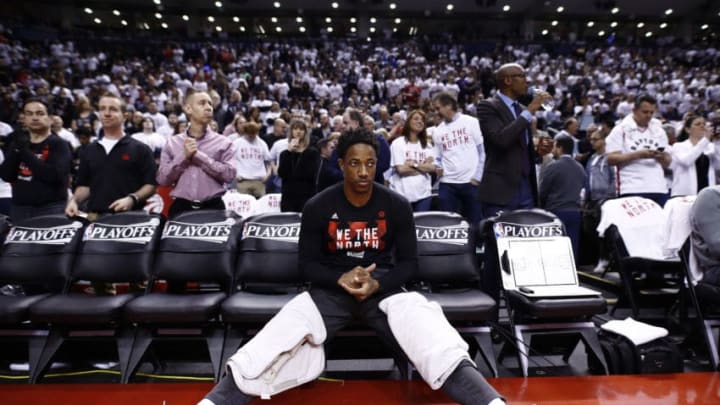If the Toronto Raptors are serious about a culture change, employing DeMar DeRozan as the primary ballhandler isn’t the answer. In fact, it won’t change much of anything.
Toronto Raptors fans have heard about the organization’s “culture change” ad nauseum this summer. Team president Masai Ujiri is on a mission to modernize the team, especially offensively, where Toronto’s play style has long been heavy on isolations and pick-and-rolls.
Head coach Dwane Casey’s offense lacks much complexity, and for a variety of personnel and coaching reasons, the Raptors shoot too few threes and generally refuse to move the ball. What the “culture change” really amounts to is more threes, more passing and a quicker pace.
If those are truly the goals, letting DeMar DeRozan run point is not how to achieve them. Nevertheless, that’s what Casey plans to do in 2017-18. Earlier this month, Casey said:
"“DeMar DeRozan, have him handle the ball a bit more as a point guard, a facilitator, a passer. Kyle Lowry moving the ball a bit more, spacing up. We don’t want to give our whole ‘what we’re going to try to do next year’ away, but again it comes down to passing the basketball and better spacing more so, than we know, one-on-one play.”"
The main complaint with Toronto’s offense is its lack of variety. DeRozan and Kyle Lowry run tons of mid pick-and-rolls with some isolations mixed in. Overall, the Raptors led the league in percentage of plays finished by the pick-and-roll ball-handler. Individually, both DeRozan and Lowry fell within the top 15 in such plays per game.
Even when the Raptors use a weave action, as in the video below, it often ends in a pick-and-roll:
DeRozan is an elite scorer with All-Star pedigree, but he’s a limited player in terms of shooting and playmaking. Giving him the ball more won’t mean pull-up threes and fun dribble hand-offs. Instead, it’ll mean more of DeRozan pounding the ball at the top of the key – in other words, more of the same.
Does merely calling DeRozan a point guard make much of a difference? It did for James Harden, it must be said, but DeRozan isn’t Harden. Houston’s experiment with The Beard worked because of his otherworldly passing ability.
Not every ball-dominant shooting guard can become a primary ball-handlerm because not every ball-dominant shooting guard averages 7.5 assists per game, as Harden did in 2015-16.
DeRozan is a pure scorer, much more comfortable creating shots for himself than for others. He can make all the simple passes. It’s just those see-them-before-they’re-there passes – point guard passes – that he hasn’t mastered.
Sometimes, mentally, you can become locked in scoring wise and lose sight of passing - DeMar DeRozan
— Raptors Republic (@raptorsrepublic) May 8, 2017
In fairness, Casey is correct that playing Lowry away from the ball opens up more space in Toronto’s attack. The diminutive point guard shot 41.2 percent from three last season, and his gravitational pull is a huge reason why DeRozan is so effective with the ball.
It’s difficult to see the “cultural” impact of greater spacing, though. Spacing and ball movement aren’t inherently connected, and in fact, perfect spacing can sometimes decrease the need for intricate passing moves. The Rockets finished 28th in the league in passes made last season, despite boasting an array of shooting weapons.
More from Toronto Raptors
- NBA Trades: 10 Pascal Siakam deals the Raptors must consider
- Grade the Trade: Warriors become title-favs in proposed deal with Raptors
- NBA Trades: Memphis bolsters their roster in this deal with Toronto
- NBA Trades: This Pelicans-Raptors deal would send a star to the Big Easy
- 3 NBA teams facing do-or-die 2023–2024 seasons
In truth, none of the Raptors’ moves this offseason make much of a stylistic difference. Their lone non-rookie addition, C.J. Miles, is tailor-made to sit in the corner while the backcourt duo handles the rock. Toronto didn’t add a point forward, or a shooter comfortable coming off screens, or an additional point guard.
Without major personnel changes, Lowry and DeRozan may have to dominate the ball. Playing style, as it turns out, is sometimes borne out of necessity more so than choice. That being said, there are some ways to utilize DeRozan offensively that will make the offense less predictable, and they involve him seeing less of the ball, not more.
The 28-year-old is deadly from midrange, so Casey can leverage that threat by running him off down screens near the elbow. Here, instead of waltzing into a slow pick-and-roll while his teammates look on as bystanders, DeRozan takes one dribble and bursts to the rim.
Casey can also use his All-Star swingman as a screener rather than a ball-handler. Here, DeRozan swings the rock to Cory Joseph, but next season, it could be Lowry swinging the ball to DeRozan.
With his defender momentarily absent, a screening DeRozan can pop to the wing and receive the ball ready to slash into the paint. These plays happen in the flow of the offense and don’t rely on Lowry and DeRozan hogging the ball.
Next: The biggest winners and losers of 2017 NBA free agency
If Casey is serious about a culture change on offense, he has the power to make it happen. Barring a major personnel shake-up though, that change has to come from his playbook, not from a misguided positional switch. DeMar DeRozan is not a point guard. Hopefully Dwane Casey knows that by now.
